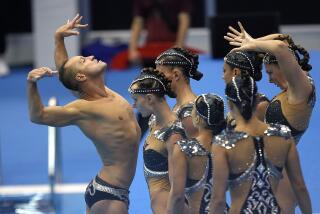Going for the Goal : Disabled Long-Distance Swimmer Sets Sights on English Channel
- Share via
He has swum around the island of Manhattan, 28 1/2 miles. Half a dozen times, he has completed a 12-mile loop around the Coronado peninsula. Once, he came within a quarter of a mile of finishing a heart-thumping crossing of the chilly English Channel before the tides turned against him.
But perhaps the toughest challenge for Jack Robertson is just getting down to the water.
Having used a wheelchair since a 1969 auto accident paralyzed his legs, Robertson must rely on buddies from the La Jolla Cove Swim Club to carefully trundle his chair down the long flight of worn concrete stairs to the beach for one of his regular training swims at the cove.
Plopping out of his chair onto the sand, the 38-year-old teacher flips on his prescription swim goggles, then pulls himself down the beach, thick arms straining and legs dragging, like a walrus heading to sea. It seems laborious and slow, but then he reaches the water.
Ah, the water! It seems to be Robertson’s element. Arms churning, he cuts across the waves like a manta ray. Turning back toward shore, Robertson and his regular training partner, Jamshid Khajavi, break into a dozen synchronized strokes of the butterfly. This is unbridled joy.
“The freedom of moving around without the wheelchair is part of it,” explained Robertson, a marathon swimmer since the early 1970s. “And I have just always loved swimming. I still love the refreshing feeling of being in the ocean, the invigoration.”
Robertson has seen a fair share of the world’s oceans. In the process, he has set marks as the first disabled person to finish swims ranging from the circumnavigation of Manhattan to the 7.6 miles from Huntington Beach Pier to the wharf in Seal Beach.
But a burning goal remains--the English Channel. Long considered the premier challenge for marathon swimmers, the channel has, so far, proved an elusive target for the barrel-chested Spring Valley resident.
Robertson has traveled to Great Britain three times to attempt the channel crossing but has yet to complete the swim, a feat no paraplegic has ever accomplished.
In 1975, Robertson got within a few hundred yards of shore after 18 hours in the numbing cold water and disorienting fog but was unable to make the final stretch when the tide reversed. Five years later he was back again but had to be pulled from the sea after a storm wheeled in and gale-force winds whipped up 10-foot swells that endangered his pilot boat.
His most recent assault came just last month, but Robertson never got a chance to get in the water.
Bad Weather Stops Attempt
Bad weather conspired to thwart any attempt at a crossing by Robertson or his traveling mates, Khajavi and fellow La Jolla Cove Swim Club members Steve France and Dave Clark (at last report, France and Clark were still in Great Britain waiting for a break in the weather to make an attempt).
Although disappointed, Robertson has kept the episode in a healthy perspective, noting the enjoyment and health benefits he and the others derived simply from training for the big swim that never came.
“It’s not just one day; it’s a process,” Robertson said. “Eventually, I’ll get the channel in. But the event shouldn’t be do or die. You need to think more in terms of the whole situation. That’s not to say I won’t put everything in to reach my goals. You just can’t be crestfallen if something happens.”
That is the sort of philosophy that has kept Robertson roaring through life, even after fate dealt a heavy blow nearly two decades ago.
At the age of 19, he and some friends from the local community college were returning to their hometown of Elyria, Ohio, from a peace rally at Ohio State University when their car skidded and plowed into a telephone poll. Robertson tumbled around in the back seat. When he came to in the wreckage, he could not move his legs. His back was broken.
Until then, Robertson had been a typical teen-age athlete--a member of the high school swim team, a lifeguard. Now he faced the gloomy prospect of never walking again.
Returned to College
He was in the hospital five months, the first half stuck in bed, the second half enduring lengthy rehabilitation sessions. Once up in a wheelchair, however, nothing could stop him. He quickly returned to college, getting a bachelor’s degree in education from Kent State University.
In 1974, Robertson moved to Scottsdale, Ariz., for a job teaching in a junior high school and coaching eighth-grade basketball. He has participated in wheelchair basketball leagues for years. It was about this time that he began training seriously for his first attempt to swim the English Channel after hearing a radio news account of a man who had completed the crossing.
The summer before the attempt, Robertson moved to Coronado so he could train in the ocean. To get in shape for the channel crossing, he would swim from Point Loma to Coronado or down to Imperial Beach.
Despite the preparation, Robertson readily acknowledged that he was the rawest of rookies when he arrived for his attempt in 1975. While training in channel waters just offshore, he wandered too far and was swept out to sea by the tides. All of a sudden, Robertson realized that huge ocean freighters were steaming by, just a few hundred yards away.
“I was miles out,” he recalled. “I didn’t know which direction was which. I was completely discombobulated. But finally this German sailor saw me and hauled me aboard his boat.”
Since he did not speak German, Robertson had a hard time communicating to the sailor that he was utterly incapable of walking. Eventually, however, the man got the picture and returned the errant swimmer to the shoreline.
Robertson arrived back after dark, expecting to find his friends frantic and the English coastal patrol searching for his carcass.
Companions Not Frantic
Not quite. His companions had not bothered making a call to authorities, figuring Robertson was just out on one of his usual long training swims. “Yeah, Jack,” they said, “we knew you were out there doing great.”
In the years since, Robertson has experienced all the joys and frustrations of the marathon swimmer. He has seen scores of sharks and seals and has swum beside whales. He has enjoyed thousands of hours of training, most of it along the chiseled shoreline stretching between La Jolla Cove and the beach at La Jolla Shores.
Robertson is a devoted “Covie,” the name given to club members and others who frequent the San Diego swimming spot. He and his constant swim partner, Khajavi, are among the best-known and best-liked cove devotees.
“If you looked up the concept of right mental attitude in the book, there would be a picture of those two,” said Mike Gibellino, president of the La Jolla Cove Swim Club. “There’s no sadness ever in either of those guys. They always have a positive outlook on life.”
Robertson credits Khajavi, a counselor with the San Diego Unified School District, as a prime helper, calling him “just a great, unselfish guy. He’s been a great swimming pal.”
When it is time to wheel Robertson up or down the steep stairs at the cove, a task accomplished by attaching a special padded bar to the back of the wheelchair, Khajavi is always there. When the water feels especially biting, Khajavi is Robertson’s partner in misery.
But it goes both ways, said Khajavi, a native of Iran who came to the United States a dozen years ago to attend college. He recalls a particularly brutal day, the water cold, the swells high. But, when he looked over at Robertson, his friend had “this smile on his face. It made me smile and begin to forget about the cold water.”
Aid From Travel Agency
Countless others have also helped. An example: The owner of a Los Angeles-area travel agency, Jake Piha of Flight Coordinators, saw a television news spot on the disabled marathon swimmer a few months ago. He called Robertson, providing him with a free airplane ticket to England.
Robertson’s biggest booster, however, is his wife of four years, Elaine. A speech pathologist in a South Bay school district, she serves as his trainer and chief crew member on the support boats that guide each marathon swim.
The couple’s three-bedroom house in Spring Valley has a swimming pool in which Robertson ticks off countless laps each day. The pool is left purposely unheated to prepare him for numbing ocean swims. Aside from the daily dips, Robertson has a barbell set at home and works out on weightlifting machines at a local gym.
But marathon swimming is not Robertson’s only passion. As a teacher of physically disabled students in the San Diego Unified School District, Robertson trains pupils to better handle their handicaps in a world that does not always lend a helping hand.
Among other duties, he is asking businesses to take part in a job-training program for disabled students. Under the program, the district trains the students to do a task and supervises them on the job. Although the students at first provide their services free, the hope is that they will work their way into a paying position, Robertson said.
He also works part time for Grossmont Hospital on an accident-prevention program aimed at teaching youngsters to “think a second” before plunging into unfamiliar water or heading off in a car without a seat belt fastened.
“The kids listen to us,” Robertson said. “I come wheeling in in this chair and tell them how I remember being just like them. I say, ‘It can happen to you.’ The statistics prove it out. But taking time to think can prevent accidents.”
In the meantime, Robertson continues to hit the water each day, driven by his love of the ocean as well as private goals yet to be achieved.
Other swims he wants to tackle include the Strait of Gibraltar, Naples Island in Italy, Lake Tahoe and Alcatraz Island to San Francisco.
And, of course, there will always be the English Channel. Robertson expects to make another assault in the summer of 1990.


